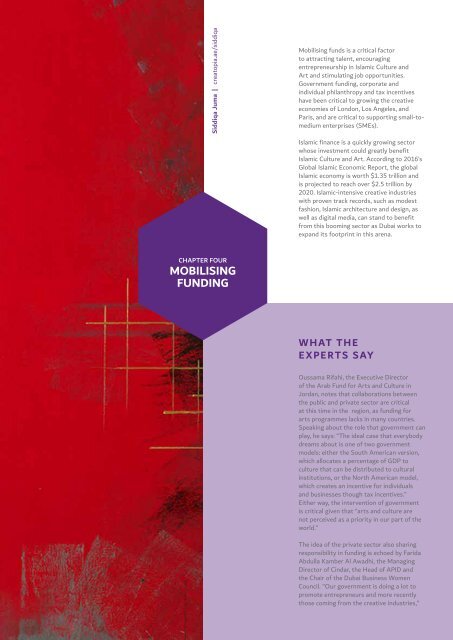9 Aug_ICAE_Book_with PT Notes
You also want an ePaper? Increase the reach of your titles
YUMPU automatically turns print PDFs into web optimized ePapers that Google loves.
38 GLOBAL PERSPECTIVES<br />
ON THE ISLAMIC CREATIVE ECONOMY<br />
Siddiqa Juma | creatopia.ae/siddiqa<br />
Mobilising funds is a critical factor<br />
to attracting talent, encouraging<br />
entrepreneurship in Islamic Culture and<br />
Art and stimulating job opportunities.<br />
Government funding, corporate and<br />
individual philanthropy and tax incentives<br />
have been critical to growing the creative<br />
economies of London, Los Angeles, and<br />
Paris, and are critical to supporting small-tomedium<br />
enterprises (SMEs).<br />
Islamic finance is a quickly growing sector<br />
whose investment could greatly benefit<br />
Islamic Culture and Art. According to 2016’s<br />
Global Islamic Economic Report, the global<br />
Islamic economy is worth $1.35 trillion and<br />
is projected to reach over $2.5 trillion by<br />
2020. Islamic-intensive creative industries<br />
<strong>with</strong> proven track records, such as modest<br />
fashion, Islamic architecture and design, as<br />
well as digital media, can stand to benefit<br />
from this booming sector as Dubai works to<br />
expand its footprint in this arena.<br />
CHA<strong>PT</strong>ER FOUR<br />
MOBILISING<br />
FUNDING<br />
WHAT THE<br />
EXPERTS SAY<br />
Oussama Rifahi, the Executive Director<br />
of the Arab Fund for Arts and Culture in<br />
Jordan, notes that collaborations between<br />
the public and private sector are critical<br />
at this time in the region, as funding for<br />
arts programmes lacks in many countries.<br />
Speaking about the role that government can<br />
play, he says: “The ideal case that everybody<br />
dreams about is one of two government<br />
models: either the South American version,<br />
which allocates a percentage of GDP to<br />
culture that can be distributed to cultural<br />
institutions, or the North American model,<br />
which creates an incentive for individuals<br />
and businesses though tax incentives.”<br />
Either way, the intervention of government<br />
is critical given that “arts and culture are<br />
not perceived as a priority in our part of the<br />
world.”<br />
The idea of the private sector also sharing<br />
responsibility in funding is echoed by Farida<br />
Abdulla Kamber Al Awadhi, the Managing<br />
Director of Cindar, the Head of APID and<br />
the Chair of the Dubai Business Women<br />
Council. "Our government is doing a lot to<br />
promote entrepreneurs and more recently<br />
those coming from the creative industries,”


